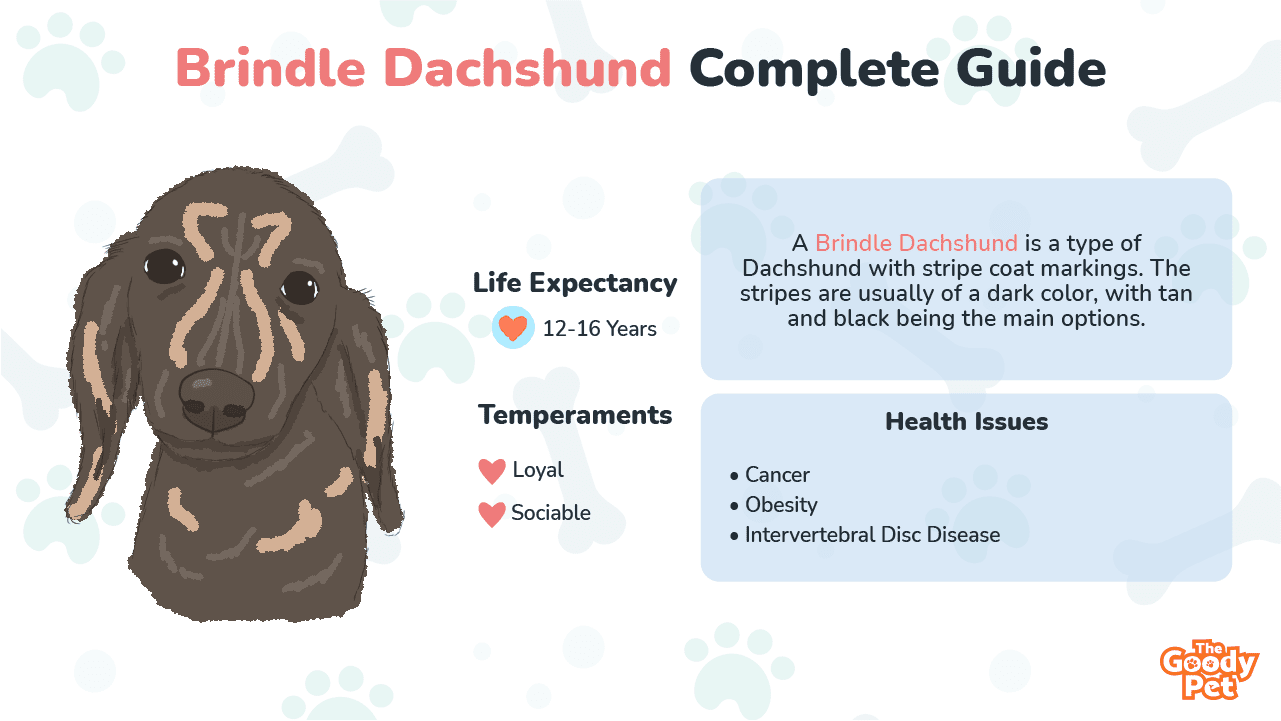Dachshunds come in many different colors and coat patterns.
The brindle pattern is one of the most common varieties, and in my opinion, these doggies are incredibly cute. I was considering getting one recently and was a little concerned about what I was getting myself into.
This is because a lot of these coat pattern variations are associated with health issues. Well, I did my research, and here is what I found out in case you are also considering getting a Brindle Dachshund.
A Brindle Dachshund is a type of Dachshund with stripe coat markings. The stripes are usually of a dark color, with tan and black being the main options. On the other hand, the base coat is often lighter, in which case tan, red, and cream are the most common coats.
The different breed regulation bodies only take one stripe on a Dachshund to qualify it as a brindle. This coat pattern results from the presence of at least one copy of the dominant brindle gene.
Brindles are definitely unique in terms of appearance. This is not all that makes them stand out in the Doxie family. Let us take a closer look into all you have to look forward to with this breed variant, from appearance to issues you may have to deal with.
What Does A Brindle Dachshund Look Like?
Brindles are known for their striped coat patterns. This is a result of the expression of the brindle gene.
The gene is a dominant one which means that only one parent needs to have it for the pups to come out brindle. The color, intensity and distribution of the stripes on the Doxie are all random and vary with the degree of expression of the genes.
The stripes themselves are usually darker than the color of the base coat. They can either be black, bluish, or tan. The base coat, on the other hand, has to be lighter. With Brindle Dachshunds, the base varieties include red, tan, and cream.
In instances where the coat is black or has darker markings and light spots, the brindle stripes only appear on the lighter patches on the doxie. They may also be present on the darker parts of the coat but, due to the lack of contrast, are harder to pick out.
However, even if only one stripe is visible, then the Dachshund is automatically considered a brindle.

Other aspects of the coat, like texture and hair length, are pretty much the same as what you would expect from a regular Doxie. More often than not, they have short and fine hair which sheds minimally.
However, they occasionally have long and sometimes wiry coats.
The build also remains the same with the iconic sausage silhouette. This means you can expect the long torso on disproportionately short and muscular legs combination that makes these lapdogs unique.
Do Dachshunds Come Only In Brindle?
According to the American Kennel Club, Dachshunds come in about 16 standard colors and combinations.
These include red, tan, black, cream, and many others. In addition to these, there are six different coat markings determined by specific genetic variations. Brindle is one of the six. Here is more about the five other patterns you may see in Dachshunds:
Dapple Dachshund
This is due to the presence of one copy of the merle gene. It results in patches, spots, or speckles of one color appearing in random shapes and locations over a different color of the base coat. The genes are also associated with visual and auditory health problems.
Double Dapple Dachshund
This is a coat pattern on Dachshunds that manifests due to 2 copies of the merle gene when two dapples mate. The pattern features white markings usually around the neck, on the tip of the tail, nose, and paws.
Piebald Dachshund
This is a pattern associated with the piebald gene. This gene is recessive, which means that to get one, you need to mate two piebalds. The resulting markings feature a white or cream base coat with darker markings like tan, black, or even fawn.
Sable Dachshund
This is one of the most subtle and difficult patterns to identify. It features darker bands near the tip of the fur strand all over the body, with the exception of fur on the face. As a result, the dog looks darker than its real coat color, which can be seen closer to the roots.
Brindle-Piebald Dachshund
This is seen with Dachshunds that have both the piebald and brindle gene. Both stripes and piebald markings are visible on the coat in random distribution.
Are Brindle Dachshunds Rare?
Brindle coat markings are attributed to the brindle gene. This is relatively common in the animal kingdom, affecting dogs and cats, and even horses.
However, when it comes to dogs, few breeds are affected, in which case the Dachshund is one of the most common dogs you will find the gene in.
The brindle gene is a dominant variant. Without turning this into a whole science class on genetics, let us simply say this makes it easier to pass down.
This is because only one parent has to have the gene for it to appear in the Doxie pup. So if you breed a Brindle Dachshund with a regular one, there will be brindles in the litter.
With this logic in mind, Brindle Dachshunds are technically not very rare.
This is in comparison to piebalds, where you have to breed two piebalds or two carriers of the gene specifically to get them. With brindles, the pattern of passing down the gene makes them easier to come by and, as a result, among the most common variant coat patterns in the Dachshund breed.
However, brindles are relatively rare without comparing them to other Dachshund coat markings (there are 25 of them as far as we know).
This is because normal coated Doxies are typically easier to come by and are more commonly bred. With brindles, on the other hand, breeding is more often than not intentional to produce the unique dog.
In a nutshell, please do not fall for the hype of shady breeders who mark up these dogs claiming that they are super rare. The truth is that though they are not the most common type of Doxie, they are considered common, so all you have to do is take your search elsewhere. You might even find one in a rescue shelter for free.
What Is The Difference Between Brindle And Dapple?
Brindle and dapples are two of the most common Dachshund coat marking varieties out there. Though vastly different, they are commonly mixed up based on vague similarities in the color combinations and marking distribution. To help you out, here is a summary of what makes them different from each other:
Genes
Dapple coat markings come from the expression of the merle gene. This is a dominant gene that affects pigmentation and often results in patches of different or absent colors not only on the coat but also on the eyes and other pigmented tissues.
On the other hand, the brindle pattern manifests because of the presence of the dominant brindle gene. Like the dapple variation, it only requires one parent to transmit it to the Doxie puppies.
Coat Markings
Here is where you can best tell the two apart.

Dapples feature different colored patches over a solid color base. The marks may be anything from multiple spots and specks to single large marks.
On the other hand, the brindle pattern presents as stripes which is why it is also known as the tiger pattern. The stripes tend to be darker than the base coat and are more often than not black or tan on red, cream, or tan.
Associated Health Problems
The dapple gene is considered problematic as it is associated with health problems in the Dachshunds. These include visual and auditory impairment that affects the quality of life for the doxie. The breeding of two Dapple Dachshunds makes these issues worse and is therefore discouraged.
The brindle gene, on the other hand, is not commonly implicated in health issues which makes breeding brindles with other brindles safe.
Common health problems plaguing can easily pile up medical costs. Fret not! Please check out pet insurance alternatives, like Pawp, if you would like to find peace of mind to provide great care for your beloved Brindle Dachshund.
Combing through the Internet, the medical costs of caring for a Brindle Dachshund can look like this.
| Condition | Costs Of Diagnosis And Treatment |
|---|---|
| Patellar Luxation | $1,500 to $3,000 |
| Corneal Dystrophy | $300 to $3,000 |
| Gastric Dilatation Volvulus (Bloat) | $1,500 to $7,500 |
| Cushing’s Disease | $3,000 to $10,000 |
| Panniculitis | $1,000 to $3,000 |
Common Health Problems Of Brindle Dachshunds
Brindle Dachshunds are typically healthy dogs if they are not bred from sick parents.
Brindle Dachshunds typically have a lifespan of 12 to 16 years like regular Dachshunds.
While the brindle gene does not carry any specific health consequences, Brindle Doxies are still at risk of getting conditions that commonly affect the breed. These include:
Intervertebral Disc Disease
IVDD is a condition that affects the form and function of the discs that separate the vertebrae on your doxie’s back. It is associated with issues like fractures and cord injury, which in turn lead to severe back pain and reduced mobility. Things will take a turn for the worse if it is not handled properly, as the weenie may end up paralyzed.
Joint Problems
The most commonly affected joints with Doxies are the knee and the hip joints. The patella running across the kneecap may become loose while the hip joint undergoes degeneration through dysplasia. Both are painful and limit mobility for the Brindle Dachshund.
Cancer
Like regular Doxies, Brindle Dachshunds are at high risk of developing cancer. The most common kinds include skin cancer, hemangiosarcoma, and tumors of the reproductive system. These commonly occur in old age and are the leading cause of non-accidental dogs in brindle and regular Dachshunds.
Obesity
Obesity happens with poor eating habits or as a result of reduced mobility which in turn affects the dog’s activity level. The best solution is to get your pooch on a healthy diet.
The Ketona Low Carb High Protein Dry Dog Food is a fantastic option. The high protein content allows for building muscle mass and losing excess weight. This would, in turn, reduce the strain on the back as the entire body weight isn’t supported there anymore.
Related Questions
How Long Do Brindle Dachshunds Live? Brindle Dachshund dogs live for 12 to 16 years. This is more or less the same as what you would expect from regular Doxies. The key is to ensure that they get to eat well, exercise regularly, and have any other health conditions taken care of as soon as possible.
Do Brindle Dachshunds Shed? Brindle Dachshunds are considered moderate shedders. This is because, more often than not, they have short and fine hair, which is relatively low maintenance. If the dog has longer fur, they are more likely to shed heavier and thus require more intense and frequent grooming. Whatever the case, they are pretty easy to take care of, and with the right practices, you can easily keep their coats healthy.
Are Brindle Dachshunds Aggressive? Brindle Dachshunds are in every way like regular Dachshunds when it comes to temperament. Despite being very friendly and affectionate, they are prone to having aggressive outbursts. This happens when they feel frustrated or threatened and can easily be prevented by discipline training and socialization.





